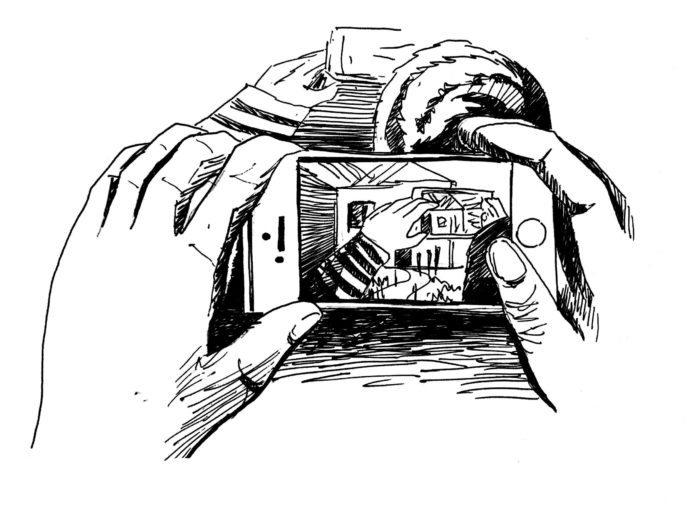It’s a surreal experience to look up and make eye contact with yourself, peering dumbstruck out of someone else’s cell phone.
My 18-year-old self is immortalized in the camera roll of the 40-something-year-old man who snapped a photo of me and three of my friends on the Metro 28 bus last weekend. He extended his arm in a mock-selfie and then — twisting his wrist — focused the frame on our faces. My initial surprise gave way to distress as I watched the stranger’s thumb press down on the little white circle at the bottom of his screen. I realized that someone I had never met now owned an image of me that he took without my consent. I considered asking him to delete the picture, but within seconds he sent it to another unknown party via iMessage. My friends and I decided to avoid confrontation and found new seats.
The walk to the back of the bus felt like a surrender. I felt guilty that I was disturbed by the incident and embarrassed that I was too afraid to do anything about it. In the 21st century, cameras are everywhere. Protections that judges and lawmakers set aside for journalists and artists now apply to anyone with a smartphone. Photography without consent or clear intention serves no purpose but to make the subjects of those photographs feel uncomfortable and unsafe.
My face has passed hundreds of security cameras and has occupied the backgrounds of uncountable selfies; it swims across my social media. It’s not a private body part. Strangers see your face every day, especially in public places — like the Metro 28 bus. The difference between those instances and my experience last weekend is consent. When I post a photo to Instagram, I allow my followers to see that photo. When I enter a convenience store with a “smile, you’re on camera” sign, I understand the store is going to use that image to ensure that I follow the law. When I’m caught in the crossfire of a casual Snapchat, I understand that the photographer has no interest in me, and my role in that image is arbitrary and irrelevant.
However, when someone intentionally photographs me without my consent — I don’t know why they are photographing me, how they’re going to use the photograph or to whom they’re going to show it. With no knowledge of the photographer’s intentions, I cannot and do not consent. This makes me uneasy. I don’t want to think about what a middle-aged man could want with a poorly lit picture of me half-asleep on a bus, and I shouldn’t have to. Not only did the photographer not obtain my consent, but his intentions were also unclear. It’s unlikely he’s going to submit that photo for the Pulitzer, or use it to inform the public. If the New York Times published an article titled “girl rides bus” we would all ask for our money back.
This is why it’s important to distinguish between individuals who photograph with good intentions and those who do not. Street photographers, for example, take photographs of unconsenting subjects for artistic reasons. Photojournalists use photographs to draw attention to global injustices. Charlie Cole won the 1990 World Press Photo Award for his famous photograph “Tank Man” during China’s Tiananmen Square protests. Cole helped to focus global attention on human rights violations in China and the bravery of the protesters holding their government accountable. In Cole’s situation, there was no way to get both the consent of his subject and capture the impact of what he was witnessing. Cole’s good intentions were clear, and therefore his photograph was justified.
Photography can also be a powerful tool for justice. Civilian videos of injustice can be admissible court evidence. The American Civil Liberties Union (ACLU) has prosecuted multiple cases in which police officers unlawfully arrested civilian photographers and videographers. The Rochester Police Department, for example, dropped misdemeanor charges against Emily Good who videotaped officers from her front yard as they searched the car of an African-American man. Good used her access to videography to hold police accountable. Her intentions justify photography without consent. However, when intentions are murky or nonexistent, individuals can abuse the protections judges have established to protect artists and journalists. Legally, it’s hard to prosecute creeps like bus-man without harming the rights of well-intentioned photographers to express themselves, especially because the definition of well-intentioned is subjective.
The best way to address this issue is with a collective shift in the way we think about when photography is or isn’t appropriate. I don’t want to live in a world where riding a bus is an automatic consent to be recorded. As a young woman, I am particularly uncomfortable with the connotations of older men taking my picture. My image belongs to me, and I should be the one to choose where it goes. If we can’t change the laws then we are responsible for changing the casual way in which we view photography without consent. When we see it happening to ourselves and others, we need to call it out for what it is: inappropriate, invasive and certifiably creepy.
Jane Walker is an undeclared first year. She can be reached at lwalker@oxy.edu.
![]()



































